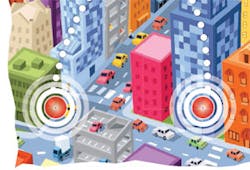Sensor Board Is Final Key To Smart-Cities Solution
WITH THE ROLLOUT of the smart grid, both consumers and energy providers hope to better monitor energy usage. Such networks will eventually include home networks, monitoring everything from appliances to entertainment and HVAC systems. In doing so, they will permit users to control their appliances and devices remotely. On a broader scale, this approach is now being mirrored by many cities. Using wireless sensor networks, cities are beginning to perform "urban monitoring," which is based on services ranging from noisepollution monitoring to smart waste management (see figure). With the addition of a new sensor printed-circuit board (PCB), for example, the Smart Cities solution from Libelium is now enabling the installation of such services.
The debut sensor board measures noise pollution, dust quantities, structural health, and garbage levels. When it is combined in a network with previously available sensor boardsfor gas monitoring, radiation detection, and smart parkingit offers a comprehensive range of sensors for urban use. These sensor boards are combined to form a heterogeneous wireless sensor network, which can be deployed for use by city councils.
Specifically, this latest PCB includes four new sensors. The noise sensor's detected sound pressure level (SPL) can be used to identify noise from traffic and people and create a real-time noise map of a city. In addition, a particulate matter (dust) sensor measures PM10 concentrations as low as 0.1 g/m3.
Targeting infrastructure, the crack sensor measures cracks in public structures, such as buildings and bridges. It can detect displacements as small as 10 m, as well as oscillations and dilations. This sensor is applicable to structural health monitoring. Lastly, an ultrasound sensor is capable of measuring garbage levels in bins. This capability can enable waste-management services to empty rubbish only from bins that are sufficiently full. As a result, such services can save both time and fuel.
The Smart Cities platform is based on Libelium's modular platform, dubbed Waspmote. It comprises the Waspmote PCB with microcontroller, memory, battery, accelerometer, and sockets for add-on modules. Also included is the open-source application programming interface (API) and compiler, along with a range of ZigBee modules offering a choice of protocol versions, radio frequency, and range (to 12 km). Additional wireless modules support Bluetooth, GPRS, and GPS. The platform exhibits impressive power management, requiring just 0.7 mA in hibernate mode. Last but not least, it also supports over-the-air (OTA) programming.
